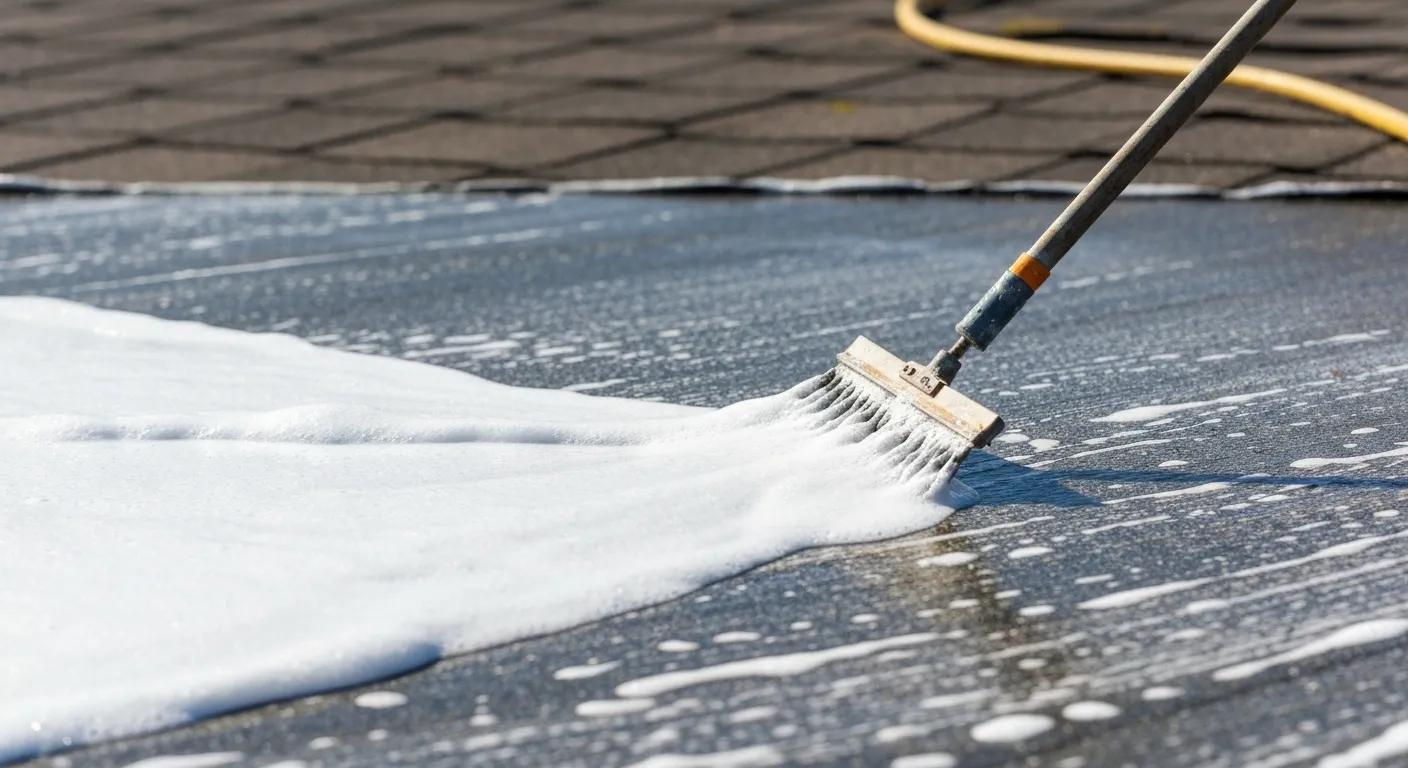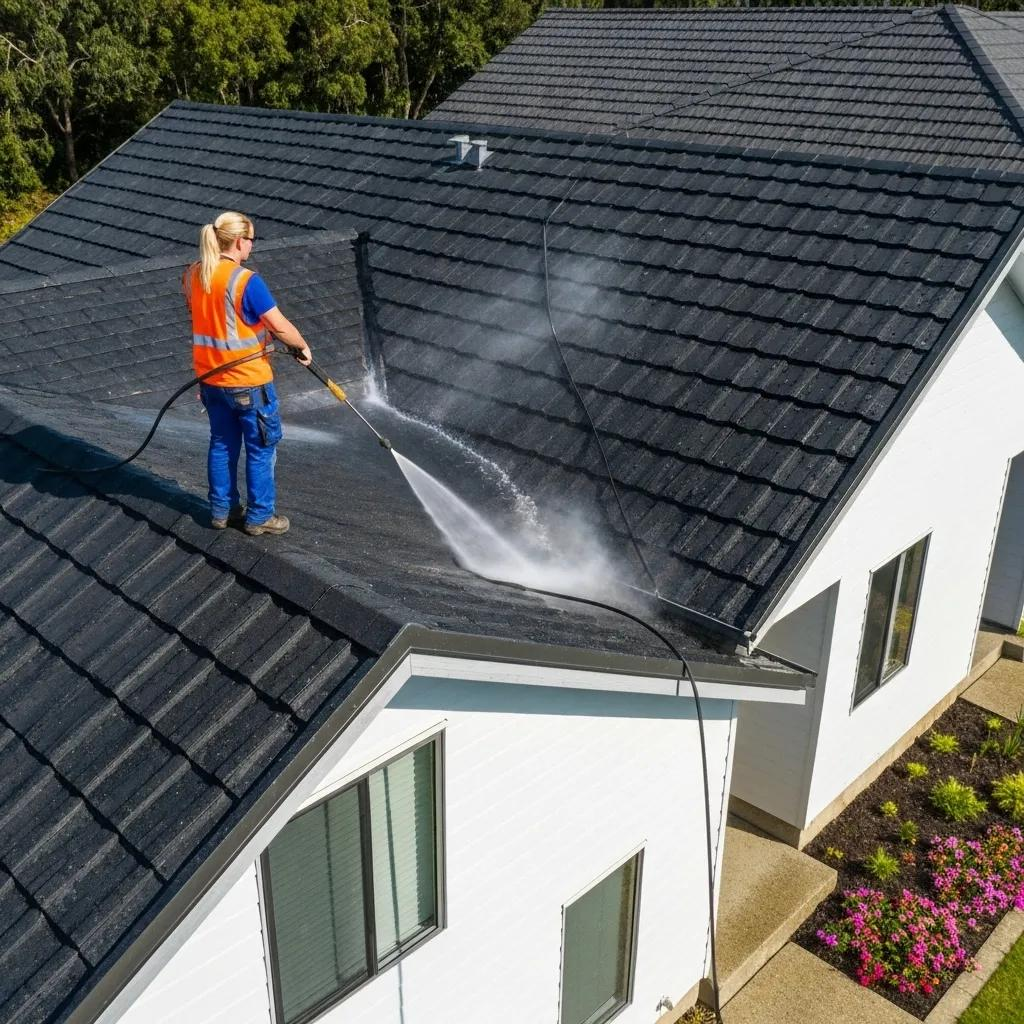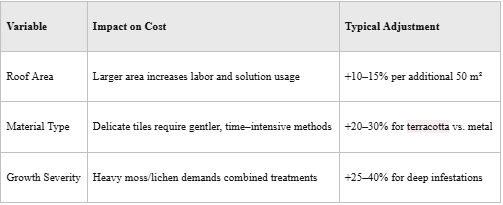A moss-covered or algae-stained roof undermines curb appeal, voids warranties, and accelerates material degradation on Adelaide homes. Recognising how persistent organic growth compromises tile integrity and water runoff is the first step toward lasting protection. In this guide, you’ll discover the five most effective roof cleaning methods such as soft washing, controlled pressure washing, chemical and biocidal treatments, manual cleaning, and strategic combinations. Each tailored to Adelaide’s climate, roof types, and environmental considerations. Learn why professional intervention matters, how to choose the right approach, what costs to expect, and which eco-friendly solutions safeguard both your home and the local ecosystem.
Why Is Professional Roof Cleaning Essential for Adelaide Homes?
Professional roof cleaning ensures safe, thorough removal of moss, algae, and lichen without damaging roofing materials. By using calibrated equipment, expert technicians eliminate contaminants that trap moisture and cause premature roof decay. For example, untreated moss on terracotta tiles can lead to cracked grout and tile slippage within months, whereas a professional soft wash restores surface health and extends lifespan.
Organic growth on roofs thrives in Adelaide’s mild winters and humid springs, creating slippery surfaces and hidden structural risks. Without routine cleaning, blocked gutters and compromised flashing accelerate leaks and wood rot. Professional services deliver preventive care that preserves water runoff, protects insulation, and enhances property value.
How Does Adelaide’s Climate Affect Roof Contaminants Like Moss and Algae?
Adelaide’s winter rains and humid summer nights encourage moss spores to germinate in tile micro-crevices, while high UV exposure dries surfaces but leaves behind calcium deposits that support algae. These conditions foster black streaks and green carpets that retain moisture, accelerating substrate breakdown.
What Are the Benefits of Regular Roof Cleaning for Roof Longevity and Curb Appeal?
Regular roof cleaning prevents tile erosion and membrane deterioration by removing abrasive growth before it penetrates protective coatings. Clean roofs reflect sunlight more efficiently, moderating attic temperatures and lowering energy costs. Visually, a spotless roof enhances street appeal, often boosting resale valuations by 3–5%.
Which Roof Types Are Common in Adelaide and How Do They Influence Cleaning Needs?
Tile, Colorbond® steel, and slate dominate Adelaide roofing. Porous terracotta and cement tiles absorb moisture quickly and require gentler cleaning, while Colorbond® metal can withstand higher pressures but may need rust inhibitors post-wash. Slate demands low-pressure methods to avoid chip fractures. Matching technique to material prevents damage and warranty voids.
What Is Soft Wash Roof Cleaning and Why Is It the Preferred Method?

Soft wash roof cleaning combines low-pressure water with specialised biodegradable detergents to dissolve organic growth at the root without mechanical abrasion. This technique kills moss, algae, and lichen via chemical action, then rinses residues gently, preserving tile integrity. As a result, roofs remain cleaner longer and coatings retain their protective function.
Soft washing addresses Adelaide’s common terracotta and slate roofs by targeting the biology of contaminants rather than blasting surfaces, which reduces erosion and granule loss. Its application extends roof lifespan by up to 30% compared to high-pressure methods, making it the preferred approach for delicate materials.
How Does Soft Washing Work to Remove Moss, Algae, and Lichen Safely?
Soft washing relies on low-pressure sprayers that apply detergent solutions of sodium hypochlorite, surfactants, and eco-friendly wetting agents. The chemicals penetrate cell walls of moss and algae, breaking down root structures and preventing regrowth. After a dwell time of 15–30 minutes, technicians rinse the roof with clean water to lift debris without scouring the surface.
What Are the Benefits of Soft Washing for Terracotta, Asphalt Shingles, and Slate Roofs?
- Terracotta Tiles Benefit: Maintains clay porosity and glaze integrity by avoiding abrasive pressure.
- Asphalt Shingles Benefit: Prevents granule dislodgement that leads to UV damage and shingle curling.
- Slate Roof Benefit: Eliminates mold and lichen from fissures without causing micro-fractures in natural stone.
Gentle application preserves warranties and reduces post-cleaning cracking, making soft washing ideal across diverse materials.
Advantages of Soft Washing and Eco-Friendly Roof Cleaning
Soft washing, utilising eco-friendly and biodegradable treatments, effectively eliminates organic growth like bacteria and algae without damaging delicate roof surfaces. This method is safer for the environment, plants, and water systems, contributing to extended roof lifespan and improved curb appeal.
What Is Adelaide Roofing and Construction’s Soft Washing Process?
- Surface Assessment: We inspect roof pitch, material, and existing damage.
- Pre-Rinse Preparation: Gutters and landscaping are shielded to prevent chemical runoff onto plants.
- Biodegradable Detergent Application: Low-pressure sprayer coats the roof with a custom-formulated solution.
- Dwell Period: Chemicals soak in for 20 minutes, disrupting moss and algae roots.
- Final Rinse: Soft rinse flushes debris into collection troughs for safe disposal.
This methodical process ensures optimal cleaning results while preserving roof warranties and landscaping health.
When Is Pressure Washing Suitable for Roof Cleaning and What Are the Risks?

Pressure washing employs high-velocity water jets to remove heavy soiling and deeply embedded growth on durable roof surfaces. When applied correctly, it strips away debris quickly, but excessive pressure can erode protective granules, crack tiles, and force water beneath shingles. Therefore, understanding its appropriate use cases and hazards is important.
High-pressure cleaning suits robust metal and concrete roofs that tolerate waterforce without structural compromise, but mandates calibrated nozzles and controlled distances to avoid substrate damage. Improper use often leads to voided manufacturer warranties and accelerated wear.
Which Roof Materials in Adelaide Are Safe for Pressure Washing?

What Are the Potential Damages and Warranty Issues from Improper Pressure Washing?
- Granule Loss: High-pressure jets shear asphalt shingle granules, reducing UV protection.
- Tile Cracking: Concentrated pressure creates micro-fractures in terracotta and slate.
- Flashing Breaches: Forceful water entry under shingles causes leaks and rot in underlying timbers.
Dangers of Pressure Washing Roofs
The National Federation of Roofing Contractors (NFRC) advises against using pressure washers for roof cleaning, as high pressures can damage tiles, remove protective laminations, and reduce the roof's overall service life. This can lead to costly repairs and void manufacturer warranties.
Manufacturers often void warranties when evidence of incorrect pressure cleaning emerges, leaving homeowners liable for repairs.
How Does Adelaide Roofing and Construction Ensure Safe Pressure Washing Practices?
Our trained technicians calibrate pressure washers by roof material, test spray patterns on inconspicuous areas, and use adjustable nozzles that limit psi. We document pressure settings and maintain logs to validate warranty compliance. This disciplined protocol delivers deep cleaning without structural harm or warranty disputes.
How Do Chemical and Biocidal Treatments Target Stubborn Roof Growth?
Chemical treatments employ bleach-based formulations, copper- or zinc-based biocides, and eco-friendly alternatives to eradicate persistent moss, algae, and lichen. These compounds penetrate organic structures, oxidise cells, and inhibit regrowth for months. By incorporating targeted chemistry, roofs remain free of staining and slippery mats without aggressive mechanical action.
Combining biocides with soft washing amplifies efficacy, especially on heritage terracotta where manual removal may leave microscopic growth behind. Treated surfaces resist recolonisation, extending cleaning intervals and preserving roof aesthetics.
What Types of Chemicals Are Used for Moss, Algae, and Lichen Removal?
- Sodium Hypochlorite Solutions: Fast-acting bleach breaks down cell walls.
- Copper Sulfate Biocides: Effective long-term inhibitor of spore germination.
- Plant-Safe Surfactants: Enhance spread and penetration while protecting flora.
These blends deliver rapid cleaning, followed by residual protection that deters regrowth for up to nine months.
How Are Safety and Environmental Impact Managed During Chemical Cleaning?
We apply neutralising agents downstream of discharge points, cover sensitive landscaping, and use drip-tray systems to collect run-off. Our biodegradable surfactants comply with local EPA regulations, ensuring that rainwater harvesting systems are not contaminated. Technicians wear full protective gear and follow SDS guidelines to maintain safe application zones.
When Should Chemical Treatments Be Combined with Other Cleaning Methods?
Chemical biocides are most effective when used alongside soft washing for initial germination disruption, then followed by manual brushing in shaded areas where solutions pool. Pressure washing may then remove residual debris safely once organic matter is chemically weakened, ensuring comprehensive eradication without undue substrate stress.
What Role Does Manual Roof Cleaning Play in Effective Roof Maintenance?
Manual roof cleaning involves hand-scraping, brushing, and targeted spot treatments to remove small patches of stubborn growth, debris in gutters, and blockages around roof penetrations. This precision work addresses areas that mechanical sprays can’t reach, such as eaves, valleys, and ridge caps. By combining manual attention with broader cleaning methods, technicians achieve thorough removal and finer surface restoration.
Hands-on cleaning preserves delicate architectural features like ornate terracotta finials and protects sealants around rooflights. It’s an essential complement to chemical and pressure techniques, ensuring hidden cracks or crevices are not overlooked.
When Is Manual Scraping or Brushing Recommended for Roof Cleaning?
Manual scraping is advised for isolated moss runnels between tiles and lichen clusters on slate, where automated sprays cannot dislodge firmly attached growth. Bristle brushes help lift softened debris after chemical treatment without gouging the substrate. This targeted approach prevents regrowth hotspots and maintains consistent roof appearance.
What Safety Precautions Are Essential for Manual Roof Cleaning?
- Secure Harnessing: Use fall–arrest systems anchored to certified tie-off points.
- Non-Slip Footwear: Ensure maximum grip on wet or mossy surfaces.
- Hand Protection: Wear chemical-resistant gloves when handling treated areas.
These measures uphold technician safety and limit liability during intricate manual operations.
How to Choose the Most Effective Roof Cleaning Method for Your Adelaide Roof?
Choosing the right cleaning method depends on roof material, age, level of contamination, and budget constraints. Evaluate whether soft washing’s gentle chemistry, pressure washing’s speed, chemical biocides’ residual protection, or manual detailing best suits your property’s needs. Matching approach to surface integrity and desired longevity minimises risks and maximises value.
A decision tree helps guide selection based on variables such as ridge tile condition, presence of paint or membrane coatings, and historical warranty requirements. Balancing cost, efficacy, and environmental safeguards ensures optimal outcomes for every Adelaide roof.
What Factors Should Influence Your Roof Cleaning Method Choice?
- Roof Material and Age
- Severity of Moss, Algae, or Lichen Growth
- Surrounding Vegetation and Shade Levels
- Budget and Maintenance Frequency
Considering these factors in concert ensures that the chosen method aligns with both performance goals and preservation of warranties.
How Does Adelaide Roofing and Construction Tailor Cleaning Solutions to Individual Roofs?
Our experts conduct a free roof audit like inspecting tile composition, slope, and previous maintenance history, then recommend a customised cleaning plan. For heritage properties we prioritise soft wash and manual treatment, whereas newer Colorbond® roofs receive calibrated pressure treatments. This bespoke approach delivers safety, compliance, and long-term protection.
Can Combining Methods Improve Cleaning Results and Roof Longevity?
Yes, hybrid strategies such as an initial biocidal soft wash, followed by manual brushing in shaded valleys and a low-pressure rinse eradicate even the most persistent growth. Integrating zinc strip installation post-cleaning further deters future colonisation, enhancing roof longevity by up to 50%.
What Are the Typical Roof Cleaning Costs in Adelaide and What Affects Pricing?
Roof cleaning costs in Adelaide range from approximately AU$300 for small, single-storey Colorbond® roofs to over AU$1,200 for large, steep-pitch terracotta installations. Key factors influencing pricing include roof area, pitch complexity, material type, level of growth, accessibility, and the chosen cleaning method. Understanding cost drivers helps homeowners budget accurately and avoid surprise expenses.
Roof Cleaning Costs and Longevity Benefits in Australia
Professional roof cleaning costs in Australia typically range from $300 to $1200, varying by roof size, material, and location. Regular cleaning is key for extending roof lifespan, preventing damage, and improving energy efficiency by allowing roofs to reflect sunlight more effectively, thereby reducing cooling costs.
Service packages often bundle cleaning with gutter clearing, moss prevention measures, and warranty inspections to deliver comprehensive protection at predictable rates.
How Do Roof Size, Material, and Growth Severity Impact Cleaning Costs?

What Value Does Professional Roof Cleaning Offer Compared to DIY Methods?
Professional services deliver certified expertise, calibrated equipment, and eco-safe solutions that homeowners rarely replicate. Professionals minimise risk of tile damage and property harm, uphold warranties, and guarantee residual protection against regrowth. This expertise often saves money by preventing costly repairs that stem from improper DIY pressure washing or chemical misuse.
How Can You Get a Free, No-Obligation Roof Cleaning Quote from Adelaide Roofing and Construction?
Simply schedule an on-site assessment through our contact form or phone line to receive a detailed, transparent estimate tailored to your roof’s size, pitch, and material. We provide itemised pricing such as covering labor, solutions, equipment, and optional preventative add-ons so you can make an informed decision with zero obligation.
What Are the Risks and Benefits of DIY Roof Cleaning Compared to Professional Services?
DIY roof cleaning can seem cost-effective initially but carries significant hazards. Untrained homeowners risk falls, chemical exposure, and irreversible roof damage that voids warranties. In contrast, professional technicians bring safety systems, compliance knowledge, and performance guarantees that protect both you and your property.
While DIY may suit minor maintenance on easy-access, low-slope roofs using gentle detergents, tackling heavy growth or fragile materials is best left to specialists.
What Safety Hazards and Potential Roof Damages Are Associated with DIY Cleaning?
- Fall Injuries: Lack of harnessing and proper ladders increases accident risk.
- Surface Erosion: Unregulated pressure washers chip granules and break tiles.
- Chemical Mishandling: Incorrect dilution or runoff containment harms landscaping and wildlife.
These hazards often outweigh initial cost savings, leading to expensive repairs and health risks.
Which Equipment and Chemicals Are Safe for DIY Roof Cleaning?
- Soft-bristle brush and garden hose for light debris
- Mild biodegradable roof cleaner diluted per label instructions
- Protective goggles, gloves, and slip-resistant footwear
These tools handle routine spot cleaning but offer limited efficacy against established growth or warranty-sensitive materials.
Why Is Hiring Adelaide Roofing and Construction’s Experts the Safer Choice?
Our licensed technicians use calibrated equipment, industry-approved chemicals, and certified fall-protection gear to deliver risk-free cleaning. We document safety protocols, carry public liability insurance, and provide workmanship warranties ensuring peace of mind that DIY efforts cannot match.
How Can Eco-Friendly Roof Cleaning Solutions Protect Your Adelaide Home and Environment?
Eco-friendly cleaning employs biodegradable surfactants, plant-based enzymes, and minimal chlorine alternatives to eradicate organic growth without harming flora, fauna, or rainwater harvesting systems. These sustainable formulas break down contaminants naturally and rinse away harmlessly, preserving Adelaide’s sensitive ecosystems.
Adopting green roof cleaning methods reduces chemical runoff into stormwater drains and supports healthy gutter ecosystems, aligning home maintenance with environmental stewardship.
What Biodegradable Cleaning Products Are Effective Against Moss and Algae?
- Non-chlorinated enzyme blends that digest organic matter
- Plant-derived surfactants that enhance penetration and rinse easily
- Mineral-based powders that absorb moisture and crumble growth upon removal
These products deliver cleaning performance comparable to traditional bleach mixtures while safeguarding waterways and gardens.
How Does Adelaide Roofing and Construction Implement Environmentally Responsible Cleaning?
We source certified green cleaning solutions, capture rinse water for safe disposal, and minimise chemical concentrations by using targeted application techniques. Our team coordinates with local water authorities to comply with Adelaide stormwater regulations and offers rainwater tank flushing services post-clean.
Can Eco-Friendly Methods Be as Effective as Traditional Chemical Treatments?
Yes, when matched with proper dwell times and occasional manual brushing, eco-friendly enzyme formulations achieve comparable removal of moss and algae. While initial treatment cycles may take slightly longer, the long-term benefits include improved roof health, reduced environmental impact, and compliance with green building standards.
What Preventative Roof Maintenance Tips Help Keep Adelaide Roofs Clean Longer?
Preventative maintenance combines scheduled cleanings, vegetation management, and passive deterrents to reduce organic growth frequency. By establishing a proactive care routine, homeowners can extend intervals between major cleanings and preserve roof warranties.
Implementing these strategies enhances roof longevity, protects gutter performance, and maintains property aesthetics year-round.
How Often Should Roof Cleaning and Gutter Maintenance Be Scheduled?
For most Adelaide roofs, professional cleanings every 18–24 months suffice, with gutter clearing at six-month intervals. Properties in heavily shaded or densely treed areas may require annual attention to prevent debris accumulation and water pooling.
What Role Do Zinc and Copper Strips Play in Preventing Moss and Algae Regrowth?
Zinc and copper strips installed along roof ridges release trace metal ions during rainfall that inhibit spore germination on surrounding tiles. This passive protection can reduce regrowth by up to 80%, extending cleaning cycles and preserving tile integrity.
How Does Tree Trimming and Property Upkeep Contribute to Roof Health?
Regularly trimming overhanging branches reduces humidity and leaf fall on roof surfaces, minimising organic debris that fosters moss and algae. Clearing vegetation improves sunlight exposure and airflow, creating conditions less conducive to microbial growth.
Professional maintenance of your roof and its environment safeguards both structural soundness and aesthetic appeal over the long term.
Adhering to these expert-recommended roof cleaning and maintenance methods ensures your Adelaide home remains protected, visually striking, and structurally sound year after year. By combining professional soft washing, calibrated pressure applications, targeted biocides, manual detailing, and eco-friendly solutions, you achieve enduring roof health. Proactive scheduling and passive prevention measures limit organic regrowth and reduce lifecycle costs. Contact Adelaide Roofing and Construction today to secure customised, compliant, and long-lasting roof cleaning solutions.

